ULTRAVIOLET PHOTOGRAPHY
Ultraviolet (UV) light is the part of the electromagnetic spectrum with wavelengths that are just shorter than that of visible light. When most people talk about ultraviolet, they are usually referring to the UVA and UVB types of UV light which are in the range of 0.3 to 0.4 microns, (300 to 400 nm). Like any other visible and near visible light, photographic equipment today can use that light for imaging.
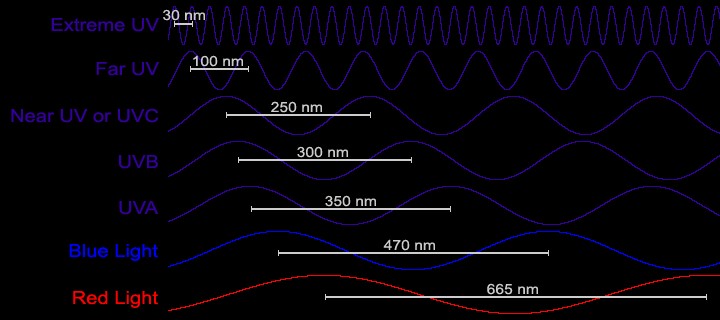
Illustrating the differences in types of UV light.

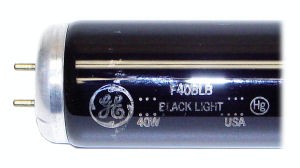
Typical UV filter and UV lamp.
Ultraviolet photography can be done with normal color or black and white film, as well as with digital cameras. In fact, almost any camera can be used to do UV photography. The only special equipment you really need is UV filters for your camera lens and a UV light source.
That being said, there are higher end multi-spectral cameras, such as the Art Innovation ARTIST system that can perform UV photography that is only in the price range of medium sized forensic labs and institutions.
There are two types of photography that can be done with UV lighting for forensic purposes. The first type is UV reflectography (UVR). With UVR, you are simply illuminating a work with UV light and photographing the resulting image with a camera using a UV lens filter. Since different materials will have different levels of opacity under UV compared to visible or infra red light, UVR can provide clues as to material composition of the pigments. UVR is also a good choice for analysis of surface roughness and detail.
For paintings, a much more useful technique is the second type of UV photography; UV fluorescence (UVF). Fluorescence occurs when a material is sensitive to UV light. The material absorbs some of the UV light, but absorbing only some of the energy from each photon. The resultant photons that are now retransmitted by the painting are emitted in the visible spectrum. Fluorescence, unlike luminescence, only exists while under direct stimulation with a UV source.
The key to UV fluorescence as a forensic tool is that not all materials are capable of fluorescence. For example, in artworks and paintings, it has been found that older varnishes fluoresce while newer varnishes will not. Additionally, older paints and pigments tend to fluoresce much more than newer paints.
With UVF then, it becomes very easy to see where retouches have been done to an old painting; the touched up areas will show up as black spots in a UV photograph of the artwork.
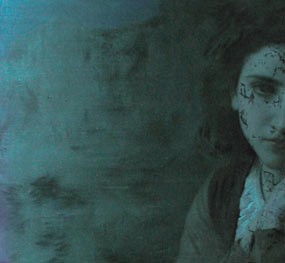
A UV analysis of the painting Mignon by William Bouguereau shows the darker areas where newer paint has been used to touch up the artwork.
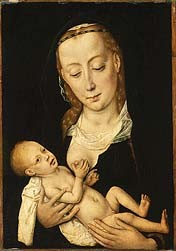
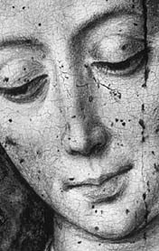
The Virgin and Child from the workshop of Dirck Bouts. the first image is the original painting. The second image is a closeup black and white photograph of the virgin
The Virgin and Child from the workshop of Dirck Bouts. the first image is the original painting. The second image is a closeup black and white photograph of the virgin’s face with UVF. The black spots and vertical crease are where retouches to the painting have been done in the past.
Similarly, spotting a fake painting could be as simple as observing that the varnish used on the artwork does not fluoresce as brightly as expected, but fluoresces a much darker color.
With color UVF photography, even more information can be garnered. Some materials commonly used with specific periods of artworks can fluoresce with very precise colors. For instance, shellac will fluoresce a particular shade of orange and older varnishes will fluoresce with a greenish hue.
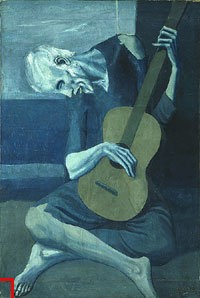
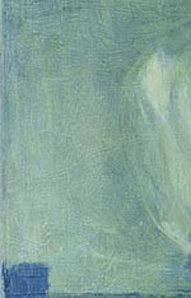
Restoration of Picasso
Restoration of Picasso’s The Old Guitarist. Red square shows the blown up area of the UVF photograph which shows the difference in fluorescence between the paint (dark blue) and the varnish after a cleaning test.
For another example, the traditional red pigment called madder will fluoresce differently than Alizarin Crimson, which is a synthetic paint that matches madder closely in color.

A UV florescence photograph of a painting showing differences in fluorescence in both the sky and the snow. Further analysis found that the difference in fluorescence was due to different pigments.
A UV florescence photograph of a painting showing differences in fluorescence in both the sky and the snow. Further analysis found that the difference in fluorescence was due to different pigments.
However, UVF as a technique is generally not sufficient on its own to prove retouches or forgeries for a couple of reasons. The first is that retouches or forgeries older than a couple of hundred years will most likely be indistinguishable from the original painting. Secondly, only some materials fluoresce and so it may be that not much information can be generated from a UVF image of the artwork. As a result, UVF can only be a reliable tool with older paintings when those paintings have a documented background of previous restorations, or when UVF is supplemented with other analysis techniques.
Because of its ability to spot previous restoration work, ultraviolet fluorescence photography is one of the primary tools of the conservator. However, almost any painting analysis will begin with UVF simply because it is a very quick and inexpensive test that can provide some very useful information and help determine the next appropriate analysis technique.
